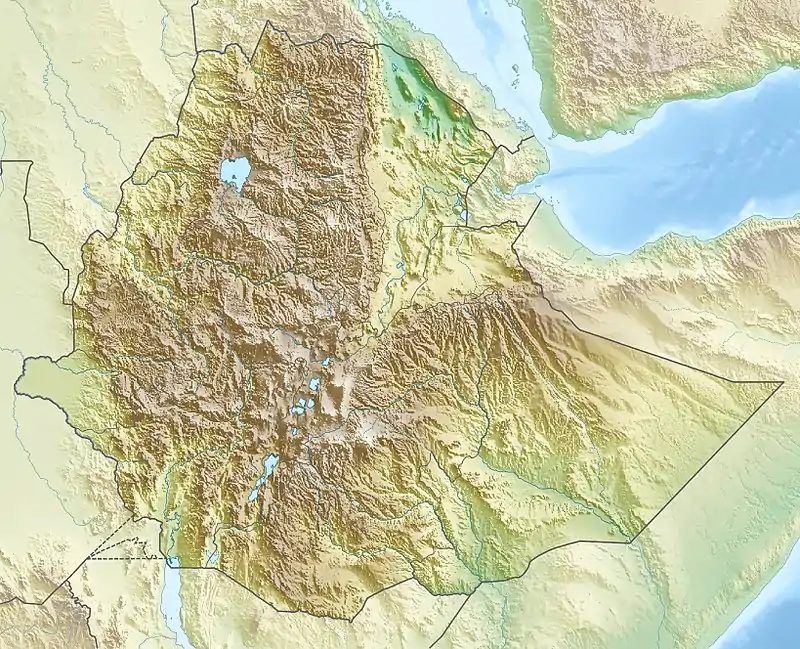Amba Geshen
Amba Geshen is the name of a mountain in northern Ethiopia. It is in Ambassel, South Wollo Zone of the Amhara Region, northwest of Dessie, at a latitude and a longitude of 11°31′N 39°21′E. Part of Ambassel woreda, Amba Geshen is one of the mountains of Ethiopia where most of the male heirs to the Emperor of Ethiopia were interned, usually for life. It was the second of the three such mountains, or amba, said to have been used for this purpose, the other two being Debre Damo and Wehni.
| Amba Geshen | |
|---|---|
| Gishen Mariam | |
 Amba Geshen Location in Ethiopia | |
| Highest point | |
| Elevation | 2,355 m (7,726 ft) |
| Coordinates | 11°31′12″N 39°21′35″E |
| Geography | |
| Location | Ambassel, Amhara Region, Ethiopia |
History
From some undetermined time, it was the practice that when the Ethiopian emperor assumed the throne, his brothers and other male relatives would be taken to a royal prison, where they would henceforth live until either they were called forth to become the new emperor or they died. Some traditions state this began during the Zagwe dynasty, others even earlier; the first certain mention of the practice was during the reign of Jin Asgad, who confined his brothers and his own sons to Amba Geshen.
The use Amba Geshen as a prison was ended by Emperor Na'od, but Manoel de Almeida mentions that "those who were there before" were guarded until the reign of Emperor Gelawdewos, when only the descendants of Emperor Takla Maryam continued to be kept under watch because of their treachery against Emperor Baeda Maryam I.[1]
Because it was a natural fortress, the Emperors also kept the imperial treasury there even after it was no longer a royal prison. The Muslims, under Ahmed Gragn, made several attempts to capture Amba Geshen: the Futuh al-Habasha describes the first (in November 1531) and second (in 1533); his final attempt in 1540 was successful, and he put the entire garrison and inhabitants to death.[2] Thomas Pakenham notes that contemporary Ethiopians believe that the True Cross was buried atop Amba Geshen by St Helena of Constantinople.[3]
Although the first European to mention Amba Geshen was Francisco Álvares, who witnessed an escaped prince being returned to Amba Geshen,[4] the earliest European to accurately describe Amba Geshen was Almeida, who states it is
- nearly round, though on top it appears to have the shape of a cross. Going along the edge of the rock, it is probably little more than half a league round on top, but one would have to walk for half a day to go round it on foot at the base. Its height is such that a stone thrown from a sling by a strong arm would reach from the bottom to the top with great difficulty. It is precipitous rock all round and in places it turns outward in such a way that it is impossible to get in. There is only one way in which... called Macaraquer.[5]
Almeidez further writes that on top there was a natural pool and spring for water, and covered by kosso and zegba brush and wild cedars. He mentions two churches: Egzyabeher Ab, built by Emperor Lalibela, and Tekle Maryam, begun by Emperor Na'od but completed by his son, Lebna Dengel, which survived Ahmed Gragn's ravages.[6] However, when Pakenham visited Amba Geshen in 1955, he found that both churches had been rebuilt with tin roofs.[7]
English literature
Another inaccurate account of Amba Geshen, called Mount Amara, was published in Purchas, His Pilgrimage, which was believed by Pakenham to have inspired John Milton's description of Paradise in Paradise Lost,[8] and later Samuel Taylor Coleridge's poem Kubla Khan.
In Samuel Johnson's Rasselas, the main character is a prince of Ethiopia who is interned in a mountain sanctuary called the "Happy Valley". To explore the world and find his own happiness, he escapes. Johnson's account was based on the travel account of Jerónimo Lobo.
References
- Translated in C.F. Beckingham and G.W.B. Huntingford, Some Records of Ethiopia: 1593-1646 (London: Hakluyt Society, 1954), pp. 101f
- Sihab ad-Din Ahmad bin 'Abd al-Qader, Futuh al-Habasa: The conquest of Ethiopia, translated by Paul Lester Stenhouse with annotations by Richard Pankhurst (Hollywood: Tsehai, 2003), pp. 254-263; 342-346.
- Thomas Pakenham, The Mountains of Rasselas (New York: Reynal & Co., 1959), p. 156
- Francisco Alvarez, The Prester John of the Indies translated by C.F. Beckingham and G.W.B. Huntingford (Cambridge: Hakluyt Society, 1961)
- Beckingham and Huntingford, Some Records, pp. 97f
- Beckingham and Huntingford, Some Records, pp. 98f
- Pakenham, Rasselas, p. 159
- Pakenham, Rasselas, pp. 139f